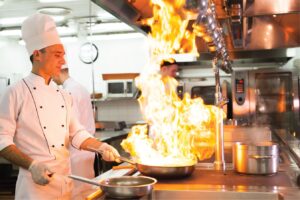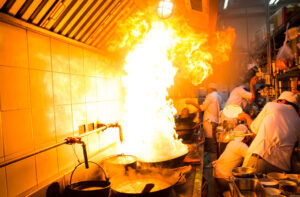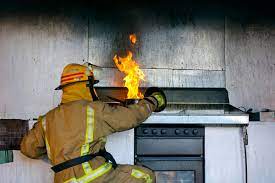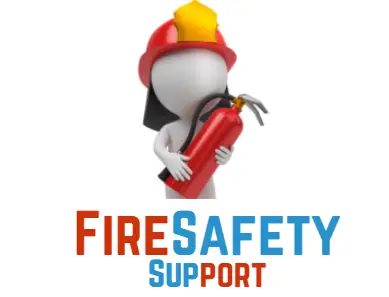A kitchen fire is one of the most common causes of home fires. According to the National Fire Protection Association, it’s responsible for 15% of all residential fires and 7% of civilian deaths. While there are ways of preventing the fire from outbreaking the kitchen, it is important you know how to put out a kitchen fire in the event that one occurs.
You should try to put out any fire that is burning in your kitchen with baking soda or a fire extinguisher (if you have one). Make sure all people are out of the kitchen and away from any possible danger before attempting to put out any flames yourself.
Using a fire extinguisher is the best way to put out the fire in your kitchen. Baking soda works, but it is not as effective as an extinguisher as it can only handle a small size of the fire. Also, you should do yourself some favor to run out and call 911 if the fire is more than what you can put yourself out.
What is a kitchen fire?
A kitchen fire is a fire that occurs in the kitchen, usually from cooking or heating. It can be caused by grease, oil, or food getting too hot and igniting.
On all grounds, the Kitchen fires are dangerous because they can spread quickly and reach high temperatures. They also produce smoke that contains toxic gases like carbon monoxide. If you’re around a kitchen fire, you should never go near it: stay as far away as possible and call 911 immediately.
Types of kitchen fires
There are many ways to start a fire in the kitchen, and each one requires a different response. Here are some of the most common types of kitchen fires and how to deal with them.
There are six types of kitchen fires:
1. Cooking fire
A cooking fire is the most common type of kitchen fire and can occur when a pot or pan catches on fire. Most often, cooking fires are caused by overheated cooking oils or grease. To prevent this type of fire, always use a lid on pots and pans to avoid splashing, and keep your stovetop clean by scraping up any food that has spilled onto it.
2. Electrical fire
An electrical fire occurs when an appliance short circuits and causes a spark that ignites nearby combustibles like paper towels or curtains. To prevent this type of fire, check electrical cords for damage and unplug appliances when they’re not in use.
3. Chemical reaction
A chemical reaction can be caused by overuse or improper storage of cleaners and other chemicals in your kitchen. To prevent this type of fire, store chemicals in their original containers and follow manufacturer instructions on safe usage amounts (such as rinsing dishes before putting them into the dishwasher).
4. Unattended appliance
An unattended appliance is an appliance that’s left on after use without being turned off at the source (for example, leaving an oven on overnight). This can cause overheating, which may lead to the ignition of combustibles nearby.
5. Upsetting
This is when you spill something on your stovetop, and it causes a fire because it hits something hot (like an electrical burner). The most common cause of this type of fire is grease from cooking with oil or butter on a hot pan.
6. Ignition
This happens when something catches on fire and ignites other materials around it, causing a larger fire than expected (like if you drop a match onto paper towels).
Read: How Much Do EMTs Get Paid?
8 Causes of a kitchen fire

Kitchen fires are the most common type of fire in the United States, with an estimated 90% of all fires occurring in the home. Kitchen fires can be caused by a variety of factors, and even small accidents can quickly become large-scale disasters.
So, here are some of the causes of the kitchen fire, and you should try to avoid them.
1. Hot oil on the stovetop
One of the most common causes of kitchen fires is hot oil on the stovetop. You might be tempted to leave your pot unattended while you go do something else in the kitchen, but that’s a big no-no.
The best way to prevent this kind of fire is to keep an eye on your pots and pans as they cook, so you can catch them before they get too hot.
2. Grease build-up in the oven or on the stovetop
Grease build-up in the oven or on the stovetop is one of the leading causes of kitchen fires. Grease is highly flammable, and it can cause flames to spread quickly through your kitchen.
If you notice that there is a grease buildup in your oven, wipe it down with a paper towel and then clean it with soap and water. If there is a grease buildup on your stovetop, use a degreaser to clean it off.
Afterward, make sure that you wipe up any excess grease or fat from around the cookware before turning on your stove or oven so that these surfaces do not become too hot and ignite an accident later on.
3. Cooking food without using a lid
The most common cause of kitchen fires is not using a lid when cooking. The reason for this is that many foods are liquids, and if they are left uncovered while cooking, they can boil over onto the stovetop and ignite. When you use a lid, it prevents this from happening by covering the pot or pan and trapping the steam inside.
4. Faulty electrical wiring or appliances
Faulty electrical wiring or appliances are the leading cause of kitchen fires. Check your home’s electrical system regularly for loose connections, overloaded circuits, frayed cords, and broken switches. If you smell burning plastic or see sparks when you turn on an appliance, shut off the power immediately and consult an electrician.
5. Spilled liquids left unattended.
Spilled liquids left unattended are the number one cause of kitchen fires. If you spill a liquid in your kitchen, make sure you clean it up right away. If you don’t have time to clean up the mess before leaving your house, make sure the stove is turned off, and all electrical appliances are unplugged.
When cooking with oil, make sure to use a high-quality pot or pan that can withstand high temperatures without breaking down. Make sure that your kitchen is well lit and ventilated. Always keep an eye on what’s cooking in order to prevent any fires from happening in the first place.
6. Overheated cooking appliances
One of the most common causes of kitchen fires is overheating cooking appliances, such as ovens and microwaves. When an appliance overheats, it can cause a fire that quickly spreads to other parts of your home.
That’s why it’s important to make sure appliances in your kitchen are clean, well-ventilated, and not left unattended while they’re on.
7. Improper disposal of hot grease
When it comes to kitchen fires, improper disposal of hot grease is one of the most common causes. Hot grease can be dangerous because it contains oil and other fats that can ignite at high temperatures.
When you’re cooking with hot grease, you should always make sure that it’s cooled down enough before putting it in the sink or on the countertop where it could spill and cause a fire.
If you do end up with hot grease on your hands or clothing, make sure to wash them off immediately with soap and water.
8. Improper handling of food
One of the most common causes of kitchen fires is improper handling of food. It’s easy to forget about something on the stovetop or just leave it unattended for too long and accidentally turn it up too high. Either way, you’ll start to notice smoke coming from your pot or pan.
This is a sign that you need to take action immediately. If the smoke is thick and black, get out as fast as possible. If it’s white or grayish, try using a lid to smother the flames by putting it on top of the pot or pan. After that, leave the room and call 911 from a safe distance away from the building.
How to put out a kitchen fire
The best way to put out a kitchen fire is with a fire extinguisher. There are three types of kitchen fires, and each requires a different type of extinguisher:
Fire extinguisher
1. Electrical
To put out an electrical fire, you’ll need an ABC dry chemical or carbon dioxide (CO2) extinguisher. These will work on anything that has been damaged by electricity, including microwaves, stoves, and toasters.
2. Flammable liquids
For flammable liquid fires, you’ll need one of two types of extinguishers: water or foam. Water works best on grease fires, while foam works better on solvents and other chemicals.
3. Combustible materials
If your cooking mishap involves combustible materials like wood or paper products, then you’ll need an ABC dry chemical or CO2 extinguisher to put the fire out quickly.
Using baking soda
If you have a kitchen fire and there is no fire extinguisher available, then you can use baking soda to put it out. Baking soda is an excellent fire extinguisher because it’s non-toxic and doesn’t leave any residue behind. It also works on all types of fires, including grease fires and electrical fires.
To use baking soda to put out a kitchen fire, pour it on top of the flames, and then cover it with a lid or some kind of heat-proof material (like aluminum foil) to shut off the oxygen supply.
You can also put out kitchen fires by using water, but be careful: if the water hits a grease fire, it could turn into steam, which could actually make the fire worse.
Importance of kitchen fire extinguisher
Kitchen fire extinguishers are an important part of your kitchen safety. They can be used to extinguish small fires and prevent them from spreading. Kitchen fire extinguishers are not the same as regular water extinguishers. They contain a chemical that helps to control the fire, rather than just putting it out.
When you have a kitchen fire, you need to act quickly. The longer the fire burns, the more damage it will cause and the harder it will be to put out. If you have a kitchen fire extinguisher in your home, you can use it to stop the spread of flames and keep them from getting out of control.

Role of smoke detector in the kitchen
The role of a smoke detector in the kitchen is simple: to protect you from fire.
Smoke detectors are a crucial part of your home safety, and they’re relatively simple devices. They are designed to detect smoke and heat that come from a fire and then alert you to it. Depending on the type of detector you have, they may sound an alarm or flash red lights to get your attention when they detect smoke.
It’s important to know how to maintain your smoke detectors, replace batteries when necessary, and follow all instructions provided by the manufacturer so that they will work properly if there’s ever an emergency in your kitchen or anywhere else in your home.
How do you respond to a kitchen fire?
If you ever find yourself in a situation where your kitchen is on fire, the first thing to do is to put out the flames. The best way to do this is with a fire extinguisher. You can find fire extinguishers in most kitchens, and they’re usually located near the stove.
If you don’t have access to a fire extinguisher, try smothering the flames with something that won’t catch on fire, like a pot lid or baking sheet.
Once you’ve put out the flames, call 911 immediately so that emergency responders can arrive at your home as soon as possible.
How to put out microwave fire
In the event of a microwave fire, follow these steps to put out the flames:
- Turn off your microwave and unplug it from the wall outlet.
- Open the door and leave it open until you are sure the fire is out.
- If the fire is contained within the microwave, place an absorbent material like baking soda or salt on top of the flames and close the door for two minutes.
- If you cannot place an absorbent material on top of the flames, use a fire extinguisher to contain them in their original location and keep them from spreading throughout your home.
How to put out an oven fire

Oven fires are scary, and they can happen when you least expect them.
To put out a fire in your oven:
- Turn off the oven and leave the door closed.
- Open windows and doors for ventilation (but be careful not to let any smoke out).
- If there’s still fire, turn on kitchen fans or air conditioners to help clear the smoke from the room (make sure they’re not pointed directly at anyone).
- Remove any food from the area immediately surrounding the oven, if possible; then put out any remaining flames with baking soda or salt.
- If that does not work, try using a fire extinguisher, and if the fire is out of hand, you should call 911
How to put out stovetop fire
The best way to put out a stovetop fire is by using a fire extinguisher. If you do not have access to a fire extinguisher, you can also use baking soda, which will help smother the flames.
If neither of these options is available, you can use a glass or metal pan to cover the flames and prevent them from spreading.
Recommended: Is Elm Good Firewood?
How to put out oil and grease fire
Oil and grease fires are often the most dangerous because they’re hard to see and can develop into full-blown explosions.
To put out an oil and grease fire:
- Turn off the stove and make sure all pots have cooled down.
- If you have any baking soda on hand, sprinkle it over the flames as soon as possible to get them under control quickly.
- If you don’t have baking soda handy, use a fire extinguisher to stop the flames from spreading further, but be sure to aim low, so you don’t hit anything flammable.
9 ways on how to prevent a kitchen fire
It’s no secret that kitchens are the most dangerous place in your home. The National Fire Protection Association reports that over half of home fires occur in the kitchen, so it’s important to stay vigilant about preventing them.
Here are some tips on how to prevent kitchen fires:
- Always keep a fire extinguisher near the stove.
- Keep pots, pans, and other cooking items off of the stovetop. It’s best to use only one pot at a time on the stovetop (you can have more than one pot on the stovetop as long as they’re not touching each other).
- Make sure your oven is clean before you start cooking so that grease doesn’t build up inside of it and catch fire later on.
- Never leave food unattended while cooking it in the oven, even if you think it’s done.
- Don’t leave cooking oil or grease on the stovetop for long periods of time
- Don’t heat up oil or grease on the stovetop for too long
- Don’t use cooking sprays that contain flammable propellants to cook or reheat food
- Don’t leave food on the grill unattended
- Keep the stovetop clean and clear of debris
Can you throw flour on a grease fire?
Yes, you can throw flour on a grease fire. Flour is actually a great way to put out a grease fire because it’s so dense that it smothers the flames and cuts off their oxygen supply. It also makes for easy cleanup afterward.
How to treat kitchen fire burn
If you’ve been burned in the kitchen, you don’t have to be a victim. Here are some tips for treating a kitchen fire burn:
- Get out of the house immediately and call 911 if needed.
- Remove any clothing that is stuck to your skin and cover the burn with a dry clean cloth or a clean paper towel.
- If your burn isn’t serious, try holding it under cool running water for 30 minutes at a time until it stops hurting (but be careful not to get too cold).
- Make sure your burn isn’t infected before treating it with aloe vera gel or hydrocortisone cream, as you can do this by checking for redness around the area of your burn and for pus or other signs of infection.
- If the burn is severe, you should reach out to your doctor.
How do you put out a kitchen fire without an extinguisher?
There are three proven ways I can suggest your put out a kitchen fire when you do not have a fire extinguisher. In all, you should always consider your safety first by getting out of the fire scene and calling for help if the fire outbreak is on the high side.
- Turn off the heat source
- Use a fire blanket or dish towel to smother the flames
- If you don’t have a fire blanket, use baking soda on the flames
Conclusion
A kitchen fire is a serious matter, especially if you are not prepared for it. The kitchen is an area where we store many flammable materials, and an accidental fire can destroy your home.
According to the National Fire Protection Association, more than 15% of home fires involve cooking equipment, and about half of these fires start with unattended cooking equipment. This means that if you leave your cooking unattended in the kitchen, there is a chance that you could be at risk of starting a fire in your home.
The good news is that there are things you can do to prevent this from happening. By following some simple tips and guidelines on how to put out a kitchen fire and ensure that your kitchen stays safe and free from fires.

